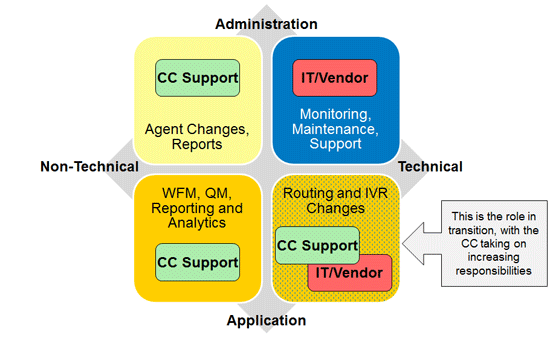Maxed out. That’s how we find many contact center leaders and their IT counterparts. Too much to do, not enough time to do it, and the urgent always trumping the important. Sound familiar?
Most centers find ways to attend to their technologies’ daily demands, some of which are routine (e.g., run reports, build schedules) and others which are on-demand (e.g., why is this happening, what is the trend, how do we address this new need, how do we address the latest issue). Few have time for the “optimize for business value” challenge. Responsibilities encompass routing and skills assignments for calls and other media (e.g., email, chat), IVR applications and interfaces, reporting and other tools to manage performance (e.g., QM, WFM, Analytics), Knowledge Management and process automation tools. Yet proper application and administration of these tools is a key to delivering technology value.
The center often wants more control but often can’t ante up resources. It’s a valid fear when they don’t have and/or don’t think they will get the right resources, compounded by the concern that the demands will be too technical.

While offerings such as cloud and managed services have the potential to alter the resource challenge situation, contact centers must choose the right partners to meet their needs. At a minimum, a partner must be as good as – or better than – the in-house IT department for implementation and ongoing support.
Whatever sourcing option makes sense for a contact center, here are three strategies to improve the value equation for technology:
Pay for professional services to design for value or get more out of your tools. Don’t expect a vendor to build it into implementation or ongoing support for free. At the same time, invest the time and energy internally to facilitate change. The single biggest thing everyone could do to increase the value of contact center technology is to ensure that when new stuff goes in, it does new and different things, rather than the same old things.
Once the vision for technology value is defined, manage the vendor from sales to implementation and support to make sure they deliver what they said they would. That means defining responsibilities and following through on accountability. Document what you really need the vendor to do, and select and negotiate (and pay for it!) accordingly. The instruments are SOWs and SLAs, not promises made during marketing and sales presentations.
Put properly trained and skilled resources (internal or external) in place to support implementation as well as leverage the technology throughout its life cycle. A technology implementation should not be treated as “set it and forget it.” Each tool needs to be adjusted to meet changing business demands as well as realize the full value that the tool has to offer. Resources with a bias toward action will move you beyond the current state and blame game to a new outcome of valuable contact center technology.
For an expanded discussion, read It’s About Time: Overcoming Resource Constraints to Deliver Technology Value.
